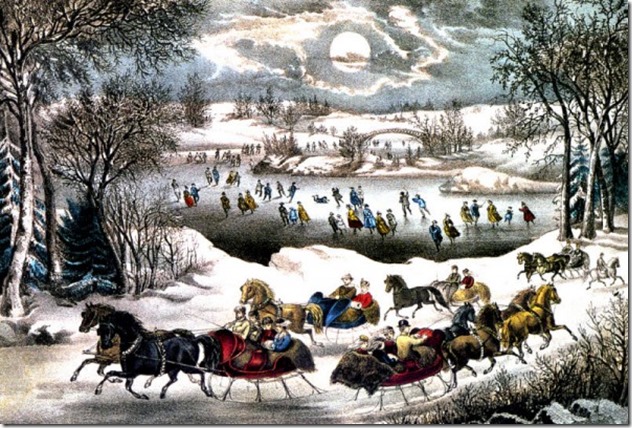Today I’m presenting a piece that is extraordinarily well-known, by an American poet whose work is still read and remembered outside of academic settings, Robert Frost.
In such cases it’s easy to think we know the poem, perhaps we’ve even memorized it in whole or in part, and we then say we know it in that special way. If we studied it in school, perhaps we learned or apprehended some deeper meanings for it. If this is so with you, I’ve had those experiences with “Stopping by the Woods on a Snowy Evening” too.
Yet, sometimes, when we look at something with intended freshness, things step out from our remembered poem and introduce us to things we didn’t realize were always there. Let’s start with just how I (and perhaps you) have visualized the setting for this poem.
In the rural winter of Frost’s time, things would be considerably more dark
.
Is Frost in a woods, a bright high-contrast Currier and Ives scene of crisp white snow and colored accents? Not as he wrote it. The title and a line in the second stanza tells us he’s on (presumably) a road, and that he is between the woods and a frozen lake. Is there a full moon and clear sky? No clear sky, it’s snowing, so overcast. He says “the darkest evening of the year,” so the moon isn’t adding significant light. In the rural New England of Frost’s time, it’s probably dark and getting darker, in a way that few of us know darkness today. There are no street lights, no farm yard lights, likely no headlights. One might see villages spotted with oil-lamp-lit windows from the crest of a hill, but he’s told us no village is in sight.
When he says he only thinks he knows “Whose woods these are,” he probably means, “I could tell you if it were noon, but not in this dark.” In the rural area of my youth, even forty years after this poem was written, directions were still given by knowing who owned (or once owned) a piece of land. Is he lost? Possibly. At the least, he wants us to know that he’s not exactly sure where he is.
At the end of the first stanza he says he stopping to watch the woods fill up with snow. If he accomplishes this, he doesn’t tell us. There are hundreds of good lines to describe snow falling on trees visually, and Frost has written many of them, but he doesn’t do it here. Is he leaving us to visualize it ourselves, from our own rich storehouse of memories? That’s possible. And if you and I remember the poem as having images of falling snow drifting through tree boughs in moonlight, that worked. My current guess is that Frost’s narrator could “see” this too, but like us, only in their mind.
It’s a testament to how thoroughly we prioritize visual imagery in poetry that we think those images are there, even if we’ve memorized the poem. Frost was especially proud of the poem’s third stanza, and justly so. It’s all sound images. The dark and solitary nature of being in the middle of un-occupied rural space at night allows sounds to take the place of what our eyes would lord over otherwise. It starts with the horse sounding his harness bells, bells not merely a decorative pretext to sing “Jingle Bells,” but a useful method of letting other narrow-road users know someone’s coming around a curve or hill-crest, particularly in the dark. And the snow image that’s really there? It’s so quiet and he’s so focused in the darkness, that he can hear the sweep of the top layer of snow blowing across the surface of the rest.
The infinite depth and darkness of the woods in the final stanza is not just a metaphor. It’s dark out, and it will not get lighter until morning. Its loveliness, invisible in the dark, is conceptual art at this point for Frost.
In this view, the decision about staying or continuing the journey is not a temptation of a seductive external snowfall-on-the-woods scene, nor is it a thought of embracing death or a contemplation of suicide, though those elements may be there as subtext. The situation is “I’m not even sure where I am on this road in the falling dark. The momentary beauty I sought here is elusive and mostly in my head. Keep following the road, though I don’t have sure landmarks and don’t know for how many miles. Better the finite, even if not quantifiable, promises of the rotating wheel of my buggy than the depth of a forest I cannot see.”
And the sleep he ends the poem with? Frost always maintained it wasn’t death in metaphorical disguise, despite what professors in electrically lit rooms might think. The story is that he wrote “Stopping by the Woods” at end of a long night of work on another, longer poem. Any writer would recognize that it’s actual sleep he now desires, rest that we only allow after exhausting our attempts to see what is lovely, dark and deep despite the night.
Musically, I sought to combine the familiar with a few twists for this one. There’s a reassuring folkie acoustic guitar part and even a cod banjo motif I played to my rusty ability. But then a cello and viola part carries throughout. Instead of bass guitar, I decided to play tambura, a traditional drone instrument of South Asian music, on my guitar using a MIDI interface.
I liked how it came out, maybe you will too. The player gadget below will let you hear it. Don’t see the player? This highlighted link will also play it.

Beautiful interpretation of this overwrought poem. It’s so nice to get to experience this (dismissed by me) text again in a fresh light (or darkness, rather). Thank you.
LikeLike
Good Stuff.
LikeLike